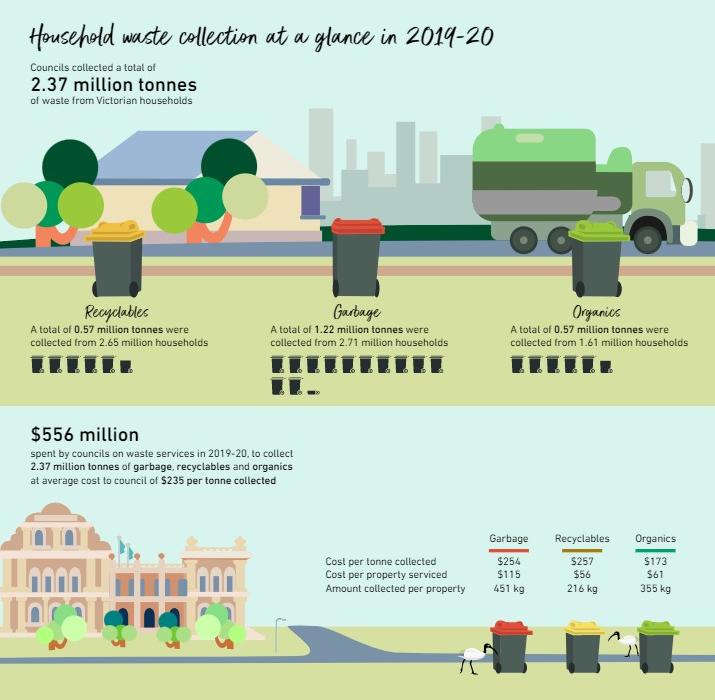Victoria’s waste in 2019-20
Below are key findings from annual waste reports:
The Waste and recycling in Victoria – Strategic summary report 2019–20 (SSR), is a strategic report which explores findings from these reports in relation to broader sector insights and trends.
Household waste
A record amount was collected, increasing by 8.1 per cent from 2018–19.
Across 79 local governments and around 2.7 million properties:
- 1.22 million tonnes of kerbside garbage was collected, an increase of 3.6 per cent from 2018–19.
- 0.58 million tonnes of kerbside recyclables was collected, an increase of 1.3 per cent from 2018–19.
Across 57 local governments and around 1.63 million properties, 0.57 million tonnes of kerbside organics was collected, an increase of 28.7 per cent from 2018–19.
The increases in tonnes collected from households is likely to be an impact of the response to the COVID-19 pandemic in Victoria with restrictions in place meaning more waste was generated at home during the reference period.
While more household waste was generated than ever before, Victorian households improved the diversion of this waste from landfill to 45 per cent, a 2-percentage point increase from 2018–19. This is indicative of a long-term trend. Since 2001–02, households have improved waste sorting behaviors at home by utilising more recyclables and organics collection services:
- recyclables collections have increased by 59 per cent or 213 kilotonnes
- organics collections have increased by 388 per cent or 454 kilotonnes
- while garbage has increased by only 10 per cent or 115 kilotonnes.
13.3% of kerbside was contaminated
On average 13.3% of kerbside recyclables was contaminated, 2.8 percentage points higher than the previous year of 10.5%. Contaminants include greasy pizza boxes, nappies, soft plastics, e-waste, used tissues or paper towels, food waste which is disposed of at landfill.
More households are using organic waste collection services
More Victorian councils introduced kerbside organic waste collection services. In 2019–20, 26.5 per cent of Victorian households used a kerbside food and garden organics collection service, almost double the proportion from 2018–19. These collections have helped Victorian’s reduce waste to landfill and the associated greenhouse gas emissions.
$556 million spent on kerbside services
An increase of 14.0 per cent since 2018–19, with garbage accounting for more than half of the cost. Per kerbside service, Victorian councils spent:
- $311 million on garbage, a 10 per cent increase since 2018-19
- $147 million on recyclables, a 22 per cent increase since 2018-19
- $99 million on organics, a 14 per cent increase since 2018-19
Per property, recyclables and organics are the most cost-effective way to dispose of our rubbish. The increased adoption of organics is not only beneficial to the environment but also to the pocket.
Total waste
15.86 million tonnes of waste generated in Victoria from all sectors
A record amount of waste was collected from municipal, commercial, industrial and construction sectors.
11.05 million tonnes of waste diverted from landfill, more than any other year
The remaining 4.81 million tonnes went to landfill, meaning we diverted 69.7 per cent of waste generated across all sectors from landfill.
10.01 million tonnes stayed on-shore for reprocessing
90.6 per cent of recovered waste remained on-shore for reprocessing. Only 9.4 per cent, or 1.04 million tonnes, was exported for further reprocessing, a decrease of 6.8 per cent from 2018–19.
The volumes recovered and exported by material as well as the diversion by material are detailed in the infographics below as well as accessible in the reports available to download here:


